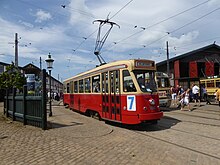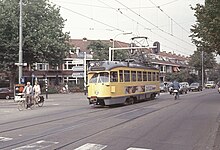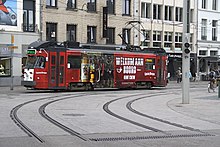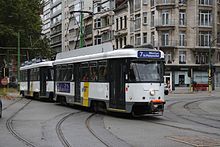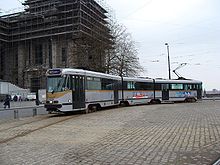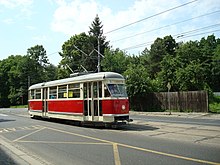PCC car

The PCC streetcar ( PCC streetcar ) is a in the 1930s in the United States developed large-capacity trams . The acronym PCC stands for Presidents' Conference Committee - it is a vehicle, the structural characteristics of which were determined in October 1929 at the conference of directors of the US transportation company.
Emergence
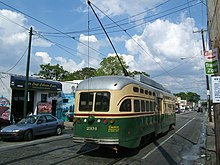


About 80,000 electric railcars were in use for passenger transport on the streetcars and intercity trams in the USA around 1920. Since the competition from omnibuses , trolleybuses and, above all, individual transport grew, wagon construction companies and individual companies began looking for ways to improve their vehicle fleets. The aim was to reduce acquisition, operating and maintenance costs and to improve them in the form of standardized individual parts, reduced driving noise, and increased availability and comfort. The several thousand tram cars built in the 1920s, including the Birney Safety Car as one of the best-selling models, were not considered to be really modern compared to their predecessors from before the First World War . They were not very comfortable and not very economical to operate.
As part of an exhibition on the occasion of the annual meeting of the American Electric Railway Association (AERA), new developments in the vehicle industry were presented in Chicago in 1929 . However, the wagons presented there did not convince the operations managers present. They created a comprehensive working group to develop a completely new, largely standardized railcar. For this purpose, the AERA members formed the Electric Railway Presidents Conference Committee (ERPCC), which was supposed to develop the “ Streetcar of the Future” . Clarence Floyd Hirshfeld , former head of research at the Detroit Edison Company , became chairman . Specific requirements and testing of existing vehicles began in Brooklyn , where two prototypes were tested in 1934. The resulting PCC car (in 1931 the ERPCC was renamed PCC) was intended to significantly improve the quality and effectiveness of the tramway.
The following were formulated as basic requirements:
- high acceleration (from 0 to 40 km / h in less than 10 seconds)
- good braking behavior (from 40 km / h to a standstill in less than 4 seconds)
- very smooth running
- low driving noise
- a low maintenance effort
- the suitability for one-man operation
- a high level of passenger comfort
- a light weight
- a modern design

The result of the considerations was a well- sprung four-axle railcar with a self-supporting lightweight construction. It allowed higher speeds, accelerated well thanks to the high drive power and still showed satisfactory braking behavior. The ends of the modern looking vehicle were rounded; the two-part windshield was tilted so that it was glare-free inside. Thanks to automatic doors, new running boards and a new type of seating arrangement, it was suitable for one-man operation without a conductor , the streamlined passenger flow enabled shorter stops and thus a higher travel speed.
The electrical equipment was developed by Westinghouse , the vehicle manufacturers were the St. Louis Car Company and Pullman Standard . Pullman presented the Type B prototype in 1934, which can be regarded as the first PCC car. The design of the furniture trolley was inspired by the streamlined modernity that was emerging at the time . The so-called accelerator and the special bogie design were new . The Transit Research Company (TRC) was founded to market the patents on the newly developed components .

In 1935 the first series vehicles were presented, which differed only slightly from the prototype. The characteristics were:
- four-axle one-way open-plan car
- All-axle drive
- Drive power approx. 4 × 40 kW
- Top speed approx. 70 km / h
- Pivot spacing 6.8 m
- Car length approx. 14.2 m
- Trolley width 2.54 m
- Front screen inclined at 12 °
- separate entry (front) and exit doors (center)
- central door control by the driver
- no conductor provided
- around 48 seats and up to 70 standing places
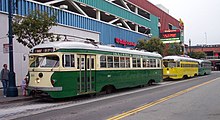
In the summer of 1936, the first production vehicles went into operation in Brooklyn and Baltimore . In terms of the car body, the PCC was less standardized than in terms of the technical equipment. It was available in various lengths and widths, in one and two-way design, with different door arrangements and designs of the front and side windows. By the time the USA entered the war in 1941, more than 2,200 cars had been built, around a third of which showed more or less significant deviations from the standard. Most of the standard cars of the so-called "pre-war design" went to Pittsburgh (400 copies) and Toronto (290 vehicles). All of them did not yet have the "standee windows", a row of small skylights below the roof edge, which are often thought to be typical of PCC cars. These windows, which were supposed to give standing passengers a better view, were first introduced in 1936, but only after 1945 as standard.
83 cars from 1936 for the Chicago Surface Lines were longer than usual and received a third door at the end of the vehicle. The capital Washington acquired a total of 365 PCCs from 1937, which were the largest non-standard series. In order to transfer tables of the local depots to fit, they were made shorter by a window, and the pivot distance was reduced to 6.3 m. The first bidirectional PCCs were received by the Pacific Electric Railway Company in Los Angeles in the late 1930s . At that time, similar-looking two-judges were already operating in San Francisco and Philadelphia, but they were not PCCs.
In order to better protect the driver from reflections, St. Louis purchased 100 PCCs in 1940 with - with a 30 ° - more inclined windshield. In the post-war design, the angle of inclination was reduced to 24 ° to save space. Because of the central platforms of their Green Line , the Boston Elevated Railway bought 20 cars with additional left-hand doors in 1941. The Los Angeles Railway was the only US company to acquire narrow-gauge railcars for its extensive Cape Gauge network , but these were wider than the standard vehicles. In addition, these were the only wagons that received modified bogies.
Overall, this type of car, developed between 1929 and 1935, was procured for the North American market well into the 1950s. By 1952, more than 5000 PCC cars for 28 transport companies were built there. The last PCC was the 1040 car for the San Francisco Municipal Railway . In addition, around 900 subway cars for Chicago, Boston, Cleveland and Philadelphia were built by the end of the 1950s , which were technically based on the PCC car.
Despite all the innovations, the PCC cars could at best slow down the decline of the trams in the USA, but not stop them. The Great American Tram Scandal led to the destruction of almost all networks - with the New Orleans tram , of all things, survived a company that had never bought a PCC.
technology

The original PCC car was a four-axle vehicle with two symmetrically built bogies and pantographs . All axles were driven, the four cradle bearing motors each made 40 to 43 kW. The H-frame bogie was heavier than older designs, but the lighter engines made up for this.
Instead of a drive switch and resistors , it was given a finely stepped “accelerator” with pedal control that combined these two elements. This new type of fine-level control enabled more precise regulation and jerk-free starting or braking. The circuit developed by Westinghouse consisted of a 99-pole roller control. With the foot pedal, the driver did not influence the speed - which was regulated by weakening the electric field - but first the acceleration. Since the motors were permanently connected in parallel, the power consumption was very high.
For the first time, the wheel sets themselves were rubber-sprung. Rubber inserts between the disc and the wheel tire reduced the rolling noise transmitted into the car; sealed, oil-lubricated axle bearings were also new. Gentle, largely jerk-free braking was achieved with a combination of accelerator, dynamic brake and magnetic rail brake .
The early vehicles still had compressed air devices for opening and closing the doors, and the brakes were also operated by compressed air. In later series electric door drives and regenerative brakes were installed (so-called all-electric cars ).
Manufacturers and operations in North America


The St. Louis Car Company and Pullman Standard were among the first manufacturers to Clark Equipment built a prototype in aluminum - lightweight construction . The vehicles for the Canadian market were manufactured by the St. Louis Car Company and the Canadian Car and Foundry in Montreal .
Toronto in Canada was the largest PCC operation in North America with 745 cars - 540 of which were purchased as new vehicles. When numerous cities gave up their trams after World War II , Toronto bought surplus cars and had them in use until the mid-1990s. The Chicago Transit Authority (CTA) bought 683 PCCs in 1948; However, within ten years their network was shut down, whereupon many of these vehicles were converted into underground cars. The second largest PCC fleet in the USA had 666 cars on the Pittsburgh Railways (from 1964: Port Authority of Allegheny County ) in Pittsburgh , most of which ended up in the blast furnaces after a few years . However, some of them ran well into the 1990s on the shrunk network in everyday work. The shorter Washington wagons, on the other hand, were a good match for some European businesses. Around 1960, larger numbers could be sold to Spain and Yugoslavia .
Most of the cities that acquired PCCs have kept their fleets relatively small. The City Subway in Newark (New Jersey) acquired 30 used PCCs in 1954, which ran there until 2001.
At some companies, PCC vehicles are still running or again:
- In Boston , modernized PCC cars are still on the road on the Ashmont – Mattapan High Speed Line .
- The Kenosha ( Wisconsin ) tram , which has been running on weekends and summer since 2000, uses old Toronto trams .
- The El Paso tram, reopened in 2018, uses reconstructed PCCs from the previous operation that was closed in 1974.
- In San Francisco , PCCs run on Line F, which is operated by historic streetcars .
Manufacturers and companies in Europe
Western Europe

In Europe, too, tram cars were manufactured in PCC design after the Second World War. There was a great need for modern vehicles in Belgium. The war had wreaked havoc on urban transport: Thousands of wagons had been destroyed or taken away by the Germans, others were completely out of date.
In 1947 a car from the USA - following a series built for Detroit - came to Brussels and Liège for test drives and to the SNCV in Ostend . Due to its width, there were hardly any possible uses for it. As early as 1942, Fiat, in collaboration with the Italian Compagnia Generale di Elettricità (CGE), had built prototypes each for Turin and Madrid , which, strictly speaking, were unlicensed plagiarism. Between 1944 and 1946 Madrid received 49 more cars from Fiat, and then another 100 from 1951 to 1958.

1945 two British manufacturers acquired licenses for the replica from the TRC. The Belgian companies La Brugeoise, Nicaise et Delcuve and Ateliers de constructions électriques de Charleroi (ACEC) received licenses in 1946, then Svenska Järnvägsverkstädera (ASJ) in Sweden in 1947 and ČKD Tatra in Czechoslovakia in 1947 . Significant numbers of PCC license cars were only produced in Czechoslovakia and Belgium.
The components for the first two railcars built at La Brugeoise in Bruges were imported from the USA. The vehicles were delivered to The Hague in the Netherlands in 1949 , they still had the typical American appearance with a two-part windshield and a large number of windows - arranged in a double row one above the other. With a car width of 2.20 m, however, they were narrower than the at least 2.54 m wide US vehicles, and the second double door was instead of in the middle of the car at the rear to allow a better flow of passengers. They were 13.9 m long, their pivot spacing was 6.3 m, the front windows were inclined by 24 °.
Even before the tests with the PCC car from the USA, the SNCV ordered 24 such vehicles from La Brugeoise. The railcars built in 1950/51 were largely similar to the American original, but they were only 2.32 m wide and had a pantograph over the front bogie instead of a pantograph . In 1960 they were resold to the Yugoslav capital Belgrade , which had already acquired five PCC cars in 1952.
Since the appearance of the car body did not meet the taste of the European public, La Brugeoise completely redesigned it. The design of Italian trams from the 1930s and 1940s was taken up. The now more pointed front was given an undivided pane in the shape of an isosceles trapezoid standing on its head . Three double doors made it possible to change passengers more quickly, with the middle door being offset to the rear. In front of that there were four, behind her two side windows in “normal” size. La Brugeoise delivered one of the first two of these PCCs to Hamburg as the 3060 car , but it was not universally applicable there. Deviating from the PCC concept - and also from its sister car Brussels - were his seat compartment shape vis-à-vis arranged. In 1958 it was handed over to Copenhagen and finally came to Brussels as Tw 7000 . The first series of 50 vehicles with the new design, the bogies of which, like the Hamburger 3060, were obtained entirely (with 24 railcars) or partially from the USA, went to Brussels from 1951 to 1953.
The Hague, however, remained largely true to American design. The first 22 cars from 1952/53 differed mainly in their shorter length and the arrangement of the doors. ASJ built two railcars for the Stockholm tram ; they were the only European PCCs to be equipped for left-hand traffic and the first to be designed for double traction . Licensed vehicles were also produced in Italy: Officina Meccanica della Stanga delivered twenty cars to Rome in 1957/58 , and Breda three to Milan .
Between 1955 and 1958, Brussels received another 105 PCCs that matched those of the first series. The bogies, electrical equipment and other parts of the last 75 of these vehicles were from cars built in 1947 for the Kansas City tram . The Hague purchased 100 cars from 1957 to 1959, which now had large side windows and a third door and were capable of double traction.
In the late 1950s, the Saint-Étienne tram began to renew its fleet of vehicles. 30 PCC vehicles with a car body width of just 2.02 m were built for the French city in 1958/59 under a sub-license from the Ateliers de Strasbourg . They had a modified front design with a front window drawn around the corner. The 61 wagons built by La Brugeoise for Antwerp from 1960 to 1962 also received this front. Your driver's seat has been moved from the center to the left to provide more space for passengers boarding.

In 1962, La Brugeoise presented a six-axle articulated car in PCC design for the Brussels tram for the first time , but it remained a one-off. In 1967/68, however, Saint-Etienne received five articulated cars, while Antwerp and The Hague - the two cities each received a further 40 PCCs - stayed with four-axle vehicles. The new Hague vehicles were 15 cm wider than their predecessors.

For the only remaining route in Marseille , La Brugeoise developed bidirectional PCCs with control stands on both sides for the first time. The cars delivered in 1968/69 resembled the cars running in Saint-Étienne and were also only 2.02 m wide, but had three symmetrically arranged double doors on each side. The Belgian city of Ghent also received 54 bidirectional cars between 1971 and 1973, without a central door, but with a width of 2.20 m. Brussels and Antwerp ordered further one-way vehicles, with the Brussels specimens being equipped with used bogies and equipment from the USA.
In the early 1970s, the development of the articulated trolley was ready for series production. All three bogies received a drive, the middle one its own accelerator. Switching between series and parallel connection of the motors served to save energy. From 1971 to 1973, 98 unidirectional and 30 bidirectional vehicles were built for Brussels, the former were converted between 1979 and 1986 for bidirectional operation, which was already an option. Antwerp bought another 40 four-axle vehicles, which were now suitable for double traction; The company converted 65 older PCCs accordingly. The Hague also stuck to four-axle wagons: of the 70 ordered, five were given a thyristor control instead of accelerators , and 30 were delivered as service wagons without a driver's seat.
The last PCC development in Western Europe were eight-axle double articulated wagons in a bidirectional design for Brussels, 60 of which were built in 1977/78 at La Brugeoise et Nivelles (since 1977: BN Constructions Ferroviaires et Métalliques). The design has been changed again, with the front windows and side windows in the form of long ribbons pulled down, and from an electrical point of view, they are two four-axle vehicles traveling in double traction. Since only control lines run through the middle section, both pantographs are always applied. The last three PCCs built in Western Europe were four-axle vehicles delivered to Marseille in 1984.
Comecon and Eastern Europe
Only a few months after Belgium, license construction began in Czechoslovakia . The Ringhoffer wagon factory in Prague had probably tried to acquire PCC licenses before 1938. In 1947 the successor company ČKD Tatra received the official license and presented the first prototype in 1951. The dimensions of the Tatra T1 corresponded roughly to the Copenhagen Type 700, its front was a new design. Inside, the T1 cannot deny its origins in the US vehicle. By 1958, 287 of these cars were built, 133 of them for the Prague tram . The Polish type 105N open- plan cars were later derived from two sample cars for the Warsaw tram . The somewhat longer and wider, beefier looking T2 was built in larger numbers and also delivered to the Soviet Union .
In total, ČKD Tatra built several thousand vehicles based on PCC; the further developed T3 was manufactured until 1989.
At the beginning of the 1960s, the Comecon decided to discontinue the independent production of tram vehicles in the states affiliated to it and to have them produced and delivered exclusively by ČKD Tatra. In this way, these vehicles were used in almost all Eastern Bloc countries , partly as modifications, such as. B. for the GDR ( T4D / B4D ) or the Soviet Union (T3SU).
With well over 10,000 units built, the T3 is the most popular type of tram in the world. On the basis of the T3, the six-axle Jakobs articulated wagons K1 , K2 and K5 were built from 1964 , the latter a two -way wagon built only for Cairo . The four-axle short articulated trolley KT4 also belongs to the PCC family in the version with accelerator, but the types T6 and KT8 equipped with a thyristor control are no longer included.
Tatra trams are still in operation in numerous companies in Central and Eastern Europe, and from the 1990s onwards, numerous wagons from East German companies were handed over to Poland, Romania, Russia and other Eastern European countries as well as North Korea.
The Tatra T2 in Pilsen has been restored to its original state
Jakobs articulated tram Tatra K5 of the Cairo tram , 1977
Short articulated trolley Tatra KT4D in Gera , 1993
Whereabouts
While numerous Tatra cars are still in use in Germany (in the five East German federal states as well as in Berlin), in Eastern Europe and in Russia, the West European PCCs have largely been withdrawn from everyday operation. In 2019, such vehicles were only still in use in Brussels (six and eight-axle vehicles) and Antwerp (four-axle vehicles). The Ghent tram company decommissioned its PCCs in 2018, but kept seven cars as a reserve and sold more bidirectional vehicles for construction site traffic to Antwerp. In The Hague, the oldest series was shut down in 1981, and in 1993 the last PCC disappeared from regular service there. Saint-Étienne parked its PCC fleet in 1998, but the four articulated cars - including car 553, which was modernized in 1982 and renumbered 001 - are still there. The Marseilles wagons were retired as part of the temporary suspension of the local trams in 2004.
In numerous cities, PCC cars are used as work vehicles (e.g. The Hague), party cars or tourist attractions for city tours (e.g. The Hague). Noteworthy is the Brussels Tw 7037 of the first series, which is in the blue and white color scheme of the tram in the twin city of Zurich in San Francisco , although a PCC was never used on their network.
PCCs can also be found in tram museums and museum trams (selection):
- Hanover Tram Museum in Wehmingen : Car 1308 and service car 2104 from The Hague, Magdeburg T4D 1008 and 1072
- Electrische Museumtramlijn Amsterdam : Car 1024 (The Hague; last PCC built with small windows)
- Skjoldenæsholm Tram Museum (Denmark): Hamburger Wagen 3060 (1958 first trial run in Copenhagen , then until 1995 as Tw 7000 in Brussels), Prague T3 7079
- Thuin Tram Museum (Belgium): SNCV 10409 (used in Belgrade from 1960 to 1985 )
- Western Railway Museum (California): San Francisco test car 1003, operational
- Seashore Trolley Museum ( Kennebunkport , Maine ): Carriages 3709 from Philadelphia, Carriages 3328 and 3332 from Boston
Others
The Polish manufacturer Konstal also used PCC technology, although it did not have a license for it. Konstal vehicles can still be found at Polish companies.
In order to avoid license fees, the UK developed its own copy of the PCC accelerator. 39 tram vehicles were equipped with the “Variable Automatic Multinotch Breaking and Acceleration Control” (VAMBAC) control: 37 cars for Blackpool and one each for Glasgow and Leeds .
In Germany , numerous variants of the Duewag articulated wagons as well as individual Duewag open-plan wagons in mold making (front) were inspired by the American PCC type, but without adopting its technology. They were used in many German and Austrian cities as well as Switzerland and the Netherlands.
Conclusion
The PCC was built, mainly as an open-plan car, in a total of around 20,000 vehicles worldwide (excluding the Tatra KT4). It proved itself in rough everyday life and set technical and external standards for two generations of tram railcars. The influence of the reliable, robust, virtually indestructible design on the size, shape and design of trams was significant. With a length of 13-14 m and a width of 2.2-2.65 m, it still serves as the basis for the design of modern articulated vehicles.
literature
- Stephen P. Carlson, Fred W. Schneider: PCC - the car that fought back . Interurban Press, Glendale, CA 1980, ISBN 0-916374-41-6 (American English).
Web links
Individual evidence
- ↑ a b c d e f g h i j k l m n o p q r s t u v PCC cars for the old world in: Straßenbahn Magazin 9/2019, p. 48 ff.
- ↑ a b c d e f g h i j k l m n o p q r s t u v The car that brought it in: Tram magazine 12/2005, p. 14 ff.
- ↑ a b c Barbara Schmucki: The dream of traffic flow on Google Books, accessed on August 29, 2019
- ↑ PCC revival in the desert in: Straßenbahn Magazin 7/2019, p. 34 ff.
- ↑ KT4. The short articulated trolley from Prague at kt4-buch.de, accessed on August 30, 2019
- ↑ "Little Brexit" on the F-Line in: Straßenbahn Magazin 9/2019, p. 14 f.
- ↑ Time travel in Belgian in: Straßenbahn Magazin 6/2019, p. 70 ff.
- ↑ Nostalgic about the Pumpkin Festival & Co. in: Straßenbahn Magazin 4/2019, p. 68 ff.
- ↑ Together into the new world in: Straßenbahn Magazin 12/2004, p. 76 ff.



